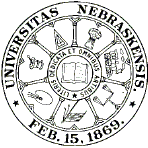
University Studies (University of Nebraska) (1888–1984)
Date of this Version
10-1954
Citation
University of Nebraska Studies, new series no. 13, November 1954
Abstract
One of the most fascinating aspects of any poet is his conception of his art. Many poets have written extensively on the theory of art around which they orient their poetry. Others have clearly revealed their theories by writing criticism of other authors. Emily Dickinson, however, left no critical essays, no elucidation of her artistic principles. It is quite probable, indeed, that she did not consciously concern herself to any extent with poetic theory. She may have written, and written in her unique way, through an instinctive need which would admit of no plodding deliberation or stylistic experimentation. Still, such a need would resolve itself in certain characteristic ways. Implicit in these ways would be an intellectual and emotional approach to poetry. I believe the main elements of that approach are discoverable. A major difficulty confronting the student of Emily Dickinson is the unsettled state of her published material. It is remarkable that the poems were published at all considering their chaotic condition in manuscript and the strange career of these manuscripts after Emily Dickinson's death. The editorial quagmire from which the published poems emerged, however, does not make the errors and shortcomings more palatable. So many errors have been detected in Poems by Emily Dickinson, edited by Martha Dickinson Bianchi and Alfred Leete Hampson, that one hesitates to accept the authenticity of the wording of any poem in the volume. Both this volume and Bolts of Melody, edited by Mabel Loomis Todd and Millicent Todd Bingham, suffer from poor organization. The poems are neither arranged chronologically nor categorized into well-defined classifications but are lumped under such inadequate headings as "Time and Eternity" and "That Campaign Inscrutable."
Despite the difficulties involved, there is ample justification for giving critical attention to Emily Dickinson's poems. In the first place, no matter who determined the final wording of the poems, many emerge as great works of genius. It is, after all, the poems, not the personalities involved, with which a student is primarily concerned. Also, by finding and compiling from Emily Dickinson's poems and letters selections which are relevant to a particular subject, the student can infer the poet's own attitudes concerning that subject. Her statements speak for themselves when systematically presented in their proper relationships and contexts, whereas the individual thoughts and attitudes are obscured in a haphazard and confusing multiplicity of themes in the present editions of her work. After sketching the background of Emily Dickinson's poetry, I shall show her attitude toward the individual word in regard to its power for communication. Next I shall discuss the mystical tendency which her poems exhibit and compare her position with traditional mysticism as treated by Evelyn Underhill in her two authoritative books, Mysticism and The Mystic Way. In the fourth chapter I shall indicate how Emily Dickinson's attitude toward communication and her mystical tendency result in a rather definite aesthetic position which affected her attitude toward the creation of poetry. I shall conclude by examining an example of her best work, "There's a certain slant of light," which exhibits many of the essential characteristics of Emily Dickinson's approach to poetry.


Comments
(c) 1954 University of Nebraska